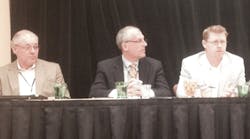PHOENIX — Your employees are connected to the Internet most of the time, so why should they not be when they’re at work? If you give your employees mobile devices, they will use them a lot, even working during off hours. And you need to control both the device and the data that it contains. Those were a few of the takeaways mechanical contractors heard here during a panel discussion on Demystifying Mobile Technologies.
“Everybody is mobile. There is a drive through our whole lives to be more connected online,” said Jim Wenninger from software supplier WennSoft. “You can’t eliminate that on the jobsite.”
Wenninger, Ben Robbins from Viewpoint Construction Software, and Steve Metzman of iBusiness Technologies addressed mobile computing issues during the Mechanical Contractors Association of America convention here.
A show of hands from the audience revealed that about half of the attendees supply mobile devices for their people.
Wenninger has the insight gained from previously co-owning Wenninger Co., a large mechanical contractor in Milwaukee.
“We originally wrote the software for ourselves,” he noted.
Wenninger argued that whatever a project manager does in the field should be available anywhere online at any time. A lot of PMs read through project materials after 9:00 PM. Why? That’s when the kids go to bed. If you give your people the tools, they will use them. Nevertheless, you must be the gatekeeper of how much information you share. Wenninger suggested allowing employees to view information but not have it reside on the device in case the phone or tablet “walks.” Metzman mention mobile device management tools, such as geo-fencing, and the ability to either lockdown or wipe a device.
Robbins maintains that connectivity in the field will become good enough that we will see wearable computing, such as Google Glass, on the jobsite. One use may be pushing data from the office, such as BIM drawings, out to the field (See Get Used to Cyber-Change Making Your Head Spin http://bit.ly/1mL8HLw). But Robbins sees that in reverse — using wearables to record what’s going on at the jobsite and sending it back to the office.
Planning is crucial, Metzman said. You can’t do ready, fire, aim. The mobile solution you pick must be scalable, i.e., if it works for 25 users, it must also work for 50 users or 75 users. It has to work on all devices, iPhone, Android and Blackberry. Different devices might be a better fit for different individuals.
You don’t need to give expensive tools to all employees and you don’t need to give all of them expensive mobile devices either, Robbins pointed out. He also suggested that you give the device to them for their personal use after 18 months; the breakage rate drops off to about 2% when you do that. And if you’re going to give someone a $500-$800 device, at least buy them a sturdy case, such as an Otterbox, in case they drop it.
Analyze your needs before you buy with your field people, not the IT people. Find out what they need to do their jobs better before you buy the devices. Don’t go cheap on the hardware, Wenninger warned. It’s cheap because it’s outdated and it probably won’t be able to handle software updates. Don’t focus on technology, Robbins warned. This is about moving information to the field, not about gadgets. That’s why you can’t let the IT folks run the show.
Speaking of software, Robbins cautioned that you’ll have to deal with employees wanting to buy their own software without asking you. Your employees’ expectations have changed and you have to compete with consumer software that’s prettier.
“You’ve got to be ahead of the curve and figure out employees needs so they’re not buying consumer software,” Wenninger said.
Metzman suggested asking employees to recommend apps. Then your IT people can vet them and, if they’re any good, they can push them out over the air to everyone’s mobile device.
What tasks can benefit the most? It’s organizationally dependent, the panelists said — you have to figure out where you can replace a piece of paper and everything that might be written on it.
Wenninger said that his firm did a survey. The number one response was getting job cost information to the project managers. Most said they wanted it weekly but they were doing it monthly because it was difficult. The second most common response was daily logs and safety reports. Number three was labor time tickets. Field supervisors need to be able to take pictures of receipts with their phones and attach them to time ticket reports.
What where the big pitfalls, the panelists were asked? Lack of planning, cheap hardware, and not talking first with the users, they said.


